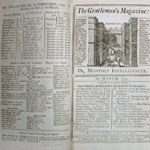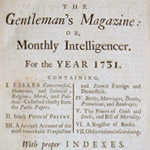 |
 |
The Gentleman's Magazine was begun by Edward Cave (1691-1754), printer and magazine proprietor, in January 1731. This compendium began as a digest of London newspapers and periodicals for country customers (thus his editorial pseudonym, Sylvanus Urban) and ended up a very successful publication, aimed at interesting the educated eighteenth-century reader. Cave, who coined the word 'magazine', attracted original verse contributions from Richard Savage, Dr Johnson, Elizabeth Carter, and Mark Akenside, and even took to popularizing science in its pages. He also published works such as Dr Johnson's Rambler (1750-52), and John Hawkesworth's Adventurer (1752-54). Special Collections is fortunate to have a complete run of The Gentleman's Magazine from January 1731 through to 1866. |

